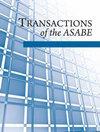Effects of Light Intensity and Photoperiod on the Growth Performance of Largemouth Bass (Micropterus salmoides) in Recirculating Aquaculture Systems
IF 1.4
4区 农林科学
Q3 AGRICULTURAL ENGINEERING
引用次数: 0
Abstract
HighlightsLight design is needed in recirculating aquaculture systems.A long photoperiod is beneficial to largemouth bass growth.Low light intensity is beneficial to largemouth bass growth.Abstract. In this study, recirculating aquaculture systems (RAS) were used to culture juvenile largemouth bass, and the effects of LED light intensity and photoperiod on the survival and growth performance of juvenile largemouth bass were studied. In the light intensity experiment, largemouth bass juveniles with an initial weight of 0.53 ±0.02 g were subjected to a two-month feeding experiment under two different light intensities: group A, at 0.5 W m-2 in the first month and 5 W m-2 in the second month; and group B, at 5 W m-2 in the first month and 0.5 W m-2 in the second month. The results showed that in the first month of the experiment, the growth rate of fry was faster in group A than in group B. After changing the light intensity, the weight of the fry in group B after one month of growth had exceeded and was significantly higher than that in group A. Based on the above experimental results, we conducted a photoperiod experiment. Largemouth bass juveniles with an initial weight of 0.56 ±0.02 g were cultured for two months under four different photoperiods (24L:0D, 16L:8D, 8L:16D, and 0L:24D). The light intensity of the four groups was 0.5 W m-2. The fry growth rate was fastest in the 24L:0D photoperiod group and slowest in the 0L:24D photoperiod group. The growth rate of the 24L:0D photoperiod group was significantly higher than that of the 0L:24D photoperiod group (p < 0.05). The final fry weight was highest in the 24L:0D group, followed by that in the 16L:8D group and 8L:16D group, with the lowest weight observed in the 0L:24D group (p < 0.05). Although the different light conditions in the two experiments had no significant effect on the survival rate of juvenile largemouth bass (p > 0.05), a low-intensity light environment with a continuous photoperiod during the juvenile largemouth bass culture process promoted growth and development. Keywords: Growth, Largemouth bass, Light intensity, Photoperiod, RAS.光照强度和光周期对循环水养殖系统大口黑鲈生长性能的影响
循环水养殖系统需要灯光设计。较长的光周期有利于大口黑鲈的生长。低光强有利于大口黑鲈的生长。本研究采用循环水养殖系统(RAS)对大口黑鲈幼鱼进行养殖,研究了LED光强和光周期对大口黑鲈幼鱼生存和生长性能的影响。光照强度试验中,初始体重为0.53±0.02 g的大口黑鲈幼鱼在两种不同光照强度下进行为期2个月的摄食试验:a组,第一个月0.5 W m-2,第二个月5 W m-2;B组第一个月5w - m-2,第二个月0.5 W - m-2。结果表明,在试验的第一个月,A组鱼苗的生长速度快于B组。改变光照强度后,B组鱼苗生长一个月后的体重已经超过并显著高于A组。基于上述试验结果,我们进行了光周期试验。选取初始体重为0.56±0.02 g的大口黑鲈幼鱼,在24L:0D、16L:8D、8L:16D和0L:24D四种不同光周期下培养2个月。四组光照强度均为0.5 W m-2。鱼苗生长速度以24L:0D光周期组最快,以0L:24D光周期组最慢。24L:0D光周期组的生长速率显著高于0L:24D光周期组(p < 0.05)。鱼苗末重以24L:0D组最高,16L:8D组次之,8L:16D组次之,以0L:24D组最低(p < 0.05)。虽然两个试验中不同的光照条件对大口黑鲈幼鱼的成活率没有显著影响(p < 0.05),但在大口黑鲈幼鱼养殖过程中,持续的光周期的低强度光照环境促进了大口黑鲈幼鱼的生长发育。关键词:生长,大口黑鲈,光强,光周期,RAS。
本文章由计算机程序翻译,如有差异,请以英文原文为准。
求助全文
约1分钟内获得全文
求助全文
来源期刊

Transactions of the ASABE
AGRICULTURAL ENGINEERING-
CiteScore
2.30
自引率
0.00%
发文量
0
审稿时长
6 months
期刊介绍:
This peer-reviewed journal publishes research that advances the engineering of agricultural, food, and biological systems. Submissions must include original data, analysis or design, or synthesis of existing information; research information for the improvement of education, design, construction, or manufacturing practice; or significant and convincing evidence that confirms and strengthens the findings of others or that revises ideas or challenges accepted theory.
 求助内容:
求助内容: 应助结果提醒方式:
应助结果提醒方式:


